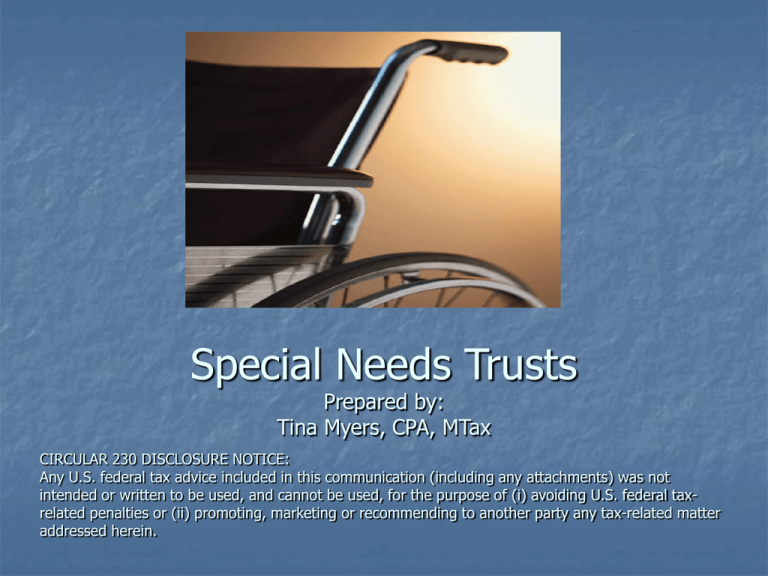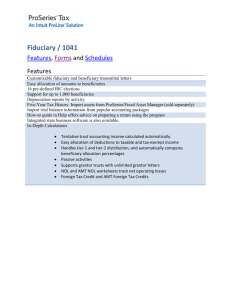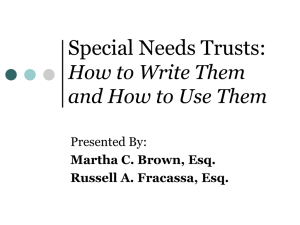Special Needs Trusts
advertisement

Special Needs Trusts Prepared by: Tina Myers, CPA, MTax CIRCULAR 230 DISCLOSURE NOTICE: Any U.S. federal tax advice included in this communication (including any attachments) was not intended or written to be used, and cannot be used, for the purpose of (i) avoiding U.S. federal taxrelated penalties or (ii) promoting, marketing or recommending to another party any tax-related matter addressed herein. Agenda Disability & concerns Public benefit eligibility Types of SNTs Grantor/Non-grantor trust status Qualified Disability trusts Conditions that Can Cause Permanent Disability: A Partial list Agoraphobia Alzheimer’s disease Amputations Bipolar disorders Caner (many types) Cerebral palsy Congenital heart disease Cystic fibrosis Downs syndrome Emphysema Fetal alcohol syndrome Fragile X syndrome Hemophilia HIV Huntington’s chorea Kidney malfunction Lupus Multiple chemical sensitivity Muscular dystrophy Obsessive-compulsive disorder Conditions that Can Cause Permanent Disability: A Partial list Organic Brain Syndrome (OBS) Parkinson’s disease Phenylketonuria (PKU) Severe autistic disorder Sickle cell anemia Spinal bfidia Tay-Sachs Syndrome Thalassemia Traumatic spine damage Turner’s syndrome Disability concerns Health care options Eligibility for Public benefits Health care options Private health care Medicare Medicaid Public benefits available Social Security Disability Insurance (SSDI) Available to individuals with a disability who either have sufficient work history prior to becoming disabled or are entitled to receive benefits by virtue of being a dependent or survivor of a disabled, retired, or deceased worker. No means testing for eligibility Public Benefits Available (con’t) Supplemental Security Income (SSI) Available to low-income individuals who are disabled, blind, elderly and have limited income and few assets. Medicare Health care program funded by government Available to all those age 65 and over Public Benefits Available (con’t) Medicaid Health care program funded by government Available to all those who meet financial eligibility requirements rather than being based on age Covers all necessary medical care. Purpose of a SNT The essential purpose of a SNT is to improve the quality of an individual’s life without disqualifying him or her from eligibility for public benefits. SNT basic characteristics Trust document states that the beneficiary with a disability cannot direct the use of funds in the trust for his or her support or maintenance, and The trust document expressly states that the beneficiary with a disability cannot revoke or terminate the trust Two Types of SNTs Self-Settled Trust Third-party Trust Pooled trusts Self-Settled Trusts Established with the beneficiary’s own funds Most commonly funded by proceeds from a lawsuit or inheritance payable directly to the disabled beneficiary Trust includes provision directing trustee to pay back anything the state Medicaid program has paid for the beneficiary Rules governing permissible distributions are more restrictive than for third-party special needs trusts Often referred to as “d4A” trusts (statutory section 42 U.S.C. §1396p(d)(4)(A)) Also referred to as a first-party trust, payback special needs trust or litigation special needs trust Self-Settled Trust Additional Rules for Grantor trusts Trust may be established by parent, grandparent or the court, even though the disabled person is the grantor. Repayment at death of beneficiary. Sole benefit requirement Must be irrevocable Beneficiary cannot be trustee or have power to remove the trustee Third-Party SNTs Established by someone other than the person with disabilities with assets never belonging to the beneficiary. Does not require a “payback” provision for Medicaid benefits upon beneficiary’s death During beneficiaries life, kinds of payments the trust can make will be more generous and flexible. Could be created during lifetime or at death. Third-Party SNTs (con’t) Trust must be discretionary There must be an independent trustee Cannot be a general support and maintenance trust Beneficiary cannot have control What public benefits can the beneficiary receive? SSDI/Medicare SSI/Medicaid Veterans benefits Subsidized Housing Temporary Assistance for Needy Families (TANF) Other means-tested benefit programs Questions to consider when establishing a SNT Are assets of the SNT includible in the beneficiary’s countable assets? When assets are transferred to a SNT, is there a penalty period? What distributions from the trust are considered countable income to the beneficiary or the beneficiary’s family? Can non-disabled, ineligible parents income and assets be deemed countable for the beneficiary’s eligibility? How do trust distributions affect the beneficiary’s public benefit? A distribution of cash reduced dollar for dollar the beneficiary’s SSI payment. A distribution that is “in-kind support and maintenance” (ISM) reduces the benefit by a lesser amount. Things that a SNT can Pay for Without Worry Home upkeep & utilities Phone, cable & internet service Vehicle, insurance, maintenance & gas Pre-paid Burial/funeral arrangements Tuition, books, tutoring Travel & Entertainment Household furnishing & furniture Television, computers & electronics Durable medical equipment Care management Therapy, medications, alternative treatments Taxes Legal, guardianship and trustee fees Personal hygiene (haircuts, manicures) Clothing What tax rules to SNTS follow? SNTs follow the same basic tax rules that all trusts follow SNT Trustee duties No self-dealing Impartiality Delegation Investment Bond Titling of Assets Accounting requirements Reporting to Social Security Reporting to Medicaid Reporting to the Court Wrapping up the trust Income taxation of SNTs Grantor trusts Generally, a SNT will be a grantor trust if a family member is the trustee. If there is an independent trustee, it may still be a grantor trust. May obtain a new EIN for the trust, or use SSN of grantor Files an “informational” return Income taxation of SNTs (con’t) Non-Grantor trusts Virtually all third-party, and some self-settled trust will be non-grantor trusts. Subject to the compressed tax rates of trusts Will need its own EIN Most likely will be classified as “complex” Files a Form 1041 with a K-1 to the beneficiary for distributions Can take deductions that would have otherwise been subject to 2% floor. Income taxation of SNTs (con’t) Qualified Disability Trusts (QDisT) Optional treatment as a QDisT Cannot be a grantor trust Since 2002, trusts qualifying under IRC Sec 642(b)(2)(C) are permitted to claim a personal exemption Trust must be funded before beneficiary turns age 65 Beneficiaries must be receiving SSI or SSDI Employment of a Caregiver May be provided through an outside agency Or a caregiver not associated with an agency. Will be treated as an employee Must withhold income and unemployment taxes Rules applicable to all SNTs There is a difference between “income” for tax purposes and “income” for purposes of SSI. If a taxpayer is under age 24, “kiddie ax” applies. Ohio Pooled Trusts Charities Pooled Trust Community Fund Management Foundation Pooled Trusts The Disability Foundation Pooled Trusts McGivney Pooled Special Needs Trust Secured Futures Pooled Trust Securet Trust Trust Sample Language The primary purpose of this trust shall be to provide for _______’s special needs resulting from his/her disabilities. In the event such beneficiary is receiving government benefits based upon need or disability, from any local, state, or federal government program, the trustee shall have the discretion to supplement those government benefits. No disbursement shall be made for _____’s benefit that would permanently jeopardize eligibility for, or inappropriately limit the type of assistance available to him/her, if he/she is receiving or intends to apply for local, state or federal benefit programs. If _____ is not receiving government benefits based upon need or disability, the Trustee shall have the absolute discretion to determine what disbursements shall be made from the trust for _____’s benefit.






